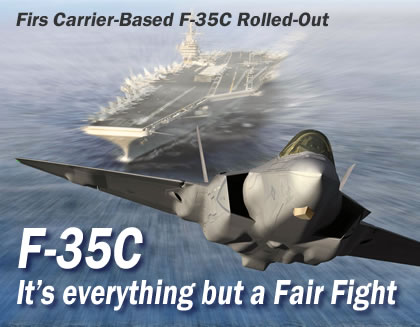
The U.S. Navy’s first stealth fighter, F-35C rolled-out in a ceremony at Lockheed Martin’s Ft. Worth TX facility July 28, 2009. Following the ceremonial roll-out the first F-35C, designated CF-1, will undergo a series of ground tests before its first flight, scheduled for late 2009. The aircraft is the ninth F-35 test aircraft to join the F-35 test fleet. Other variants of the Lightning II have logged more than 100 flights. The remaining ten aircraft of the test fleet are currently in various phases of production.

“The JSF will show the world that our Sailors will never be in a fair fight because this airplane will top anything that comes its way,” said Adm. Gary Roughead, the U.S. Navy’s Chief of Naval Operations. “It will give our Sailors and pilots the tactical and technical advantage in the skies, and it will relieve our aircraft as they age out.” Tom Burbage, a former Navy test pilot and the executive vice president and general manager of F-35 Program Integration for Lockheed Martin, said the Navy has already began to “actively working to define joint and coalition tactics that will exploit this platform in ways we’ve never envisioned. We at Lockheed Martin are both proud and humbled by the trust the U.S. Navy has placed with us to lead the development and introduction of the Navy’s newest stealthy, supersonic strike fighter.”
The F-35C will be operating from the U.S Navy’s aircraft carrier decks via catapult launch and arrested recovery. Its distinctive features include larger, folding wings and control surfaces and the addition of wingtip ailerons, allow the F-35C pilot to control the airplane with precision during carrier approaches. The aircraft incorporates larger landing gear and a stronger internal structure to withstand the forces of carrier launches and recoveries.
The naval variant of the F-35 has an internal fuel capacity of nearly 10 tons, providing an unrefueled range of over 1,200 miles without external tanks. The standard internal weapons load is two AIM-120C air-to-air missiles and two 2,000-pound GBU-31 JDAM guided bombs. Optional internal loads include eight GBU-38 small-diameter bombs, as a variety of air-to-ground missiles, dispensers and guided weapons. The internal weapons bay can be configured for all air-to-ground ordnance, all air-to-air ordnance or a blend of both. A missionized version of the 25 mm GAU-22A cannon is installed or removed as needed. When stealth is not required to execute a mission, the F-35C can mount external stores and weapons on underwing pylons, giving the aircraft a weapons payload of more than 18,000 pounds.
As the aircraft becomes operational, around the year 2015 it will introduce the U.S. Navy carrier task forces with 5th generation fighter capabilities at sea, gaining improved operational freedom gained by its stealth, super-cruise and agility and air dominance, based on its sensor package network-centric operability. Another important aspect is the new fighter’s availability and support – the Lightning II’s operational and support costs are expected to be lower than those of current carrier-based fighters.
The use of materials and techniques reducing radar and thermal signature have different implications for aircraft operatoring in a maritime enviornment. The use of ruggedized exterior materials mean, more ressistant to salt and spray corrosion mean lower maintenance requirements for preserving the aircraft’s Very Low Observable radar signature, even in harsh shipboard conditions.
Adm. Gary Roughead, the U.S. Navy’s Chief of Naval Operations, addresses the crowd at the rollout ceremony of the first F-35C Lightning II carrier variant Photo: Lockheed Martin



















